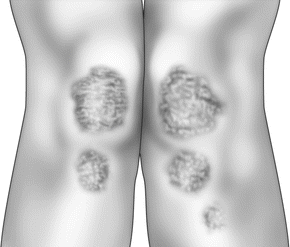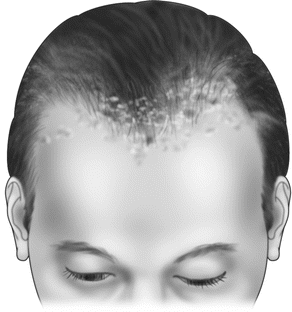, Toral Patel3, 4, Neill T. Peters3, 2 and Sarah Kasprowicz5
(1)
Northwestern University Feinberg School of Medicine, Chicago, IL, USA
(2)
Medical Dermatology Associates of Chicago, Chicago, IL, USA
(3)
Instructor of Clinical Dermatology, Northwestern University Feinberg School of Medicine, Chicago, IL, USA
(4)
D&A Dermatology, Chicago, IL, USA
(5)
NorthShore University HealthSystem, University of Chicago, Pritzker School of Medicine, Chicago, IL, USA
Keywords
PsoriasisFish oilIndigo naturalisAloe veraMahonia aquifoliumBalneotherapyMindfulness based stress reductionTurmericCurcuminIntroduction
Psoriasis is a common dermatologic condition, affecting approximately 2–3% of the population worldwide. The presence of large plaques on exposed areas of the body can cause significant embarrassment and social anxiety for those with psoriasis. There have been a number of exciting developments in the understanding of the pathogenesis of psoriasis, and with those have come several new classes of medications (Richard and Honigsmann 2014). Fortunately, there are multiple conventional options now that can manage psoriasis very effectively, and many of these are appealing to patients who prefer a more natural approach. From topical vitamin D analogues (calcipotriene and calcipotriol), phototherapy utilizing narrow band UVB light, and even a recently FDA-approved blue light home treatment for psoriasis (Kleinpenning et al. 2012), there are many potential choices in the conventional armamentarium. Some of the most powerful treatments, however, bring with them significant risks such as hepatotoxicity for methotrexate, the possibility of serious infections, malignancies, and autoimmune syndromes from the biologic agents, and depression and suicidality from a newer oral phosphodiasterase-4 inhibitor.
These risks, perhaps, as well as the chronic nature of the disease remain frustrating for these individuals, and many turn to complementary and alternative medicine (CAM) as an addition or even replacement for conventional therapies. In a recent survey of 57 patients with psoriasis, almost 50% of them had used a CAM method of treatment in the preceding year (Damevska et al. 2014). CAM treatments included topicals, systemic therapies, and dietary modifications. While there is limited data on many of these therapies, it is important for dermatologists to be aware that CAM use among psoriasis patients is fairly common, and to be able to explain the risks and benefits of the more commonly used therapies with a relative degree of comfort. Patients should be encouraged to report all medications they are using, both prescription and alternative, so any possible interactions with concomitant medications or other potential risks can be addressed.
Clinical Considerations
See Figs. 8.1 and 8.2.



Fig. 8.1.
Cutaneous lesions of psoriasis typically manifest as erythematous plaques with silver scale on the trunk and extremities, often over areas subject to chronic friction such as the elbows and knees. The scalp and face may also be involved, as well as the axillae and groin (inverse psoriasis).

Fig. 8.2.
Psoriasis often affects the scalp, with erythematous scaly plaques that may be pruritic.
Top Considerations
See Table 8.1.
Table 8.1.
Top considerations for psoriasis.
Treatment | How administered | Notes |
|---|---|---|
Fish oil | Capsules (up to 10 per day in one study) | Safe; fishy taste and GI upset may limit use in some patients, dosage unclear (but was approximately 10,000 mg of EPA per day in one study) |
Indigo naturalis | Topically as cream | Well-tolerated; may stain skin and fabric, may be difficult to source |
Curcumin | Orally (3–4.5 g per day in studies) or as a topical gel (1%) | Safe and inexpensive; GI upset in some patients |
Aloe vera | Topically as a gel | Safe; possibility of cutaneous irritation or contact dermatitis |
Baking soda | As a bath soak, 350–500 g (about 2 cups) per full tub every other day | Inexpensive and well-tolerated |
Mahonia aquifolium | Topically as a cream | May be difficult to find commercially; may cause irritation and stain clothing |
Balenotherapy | Salts mixed in bath at home 3–7 times per week | Safe and inexpensive; time consuming and modest effect |
Mindfulness relaxation | With therapist or via recorded sessions | Very safe; may be difficult to find practitioner, may be expensive |
Fish Oil
Oil from cold water fish such as salmon, cod, sardines and herring are rich in the omega-3 essential fatty acids eicosapentaenoic acid (EPA) and docosahexaenoic acid (DHA). These fatty acids have been shown to possess anti-inflammatory properties and have been studied for their use in psoriasis (Nicolaou 2013). Other good sources of omega-3 fatty acids include walnuts, flax seed, and olive oil. There is no standardized dosing for the use of omega-3 fatty acids in psoriasis; patients may be advised to increase intake via dietary consumption or via oral supplements.
Evidence for Fish Oil
1.
Double-blind, placebo-controlled study to evaluate the efficacy of fish oil and low-dose UVB in the treatment of psoriasis. Gupta AK, Ellis CN, Tellner DC, Anderson TF, Voorhees JJ. Br J Dermatol. 1989 Jun;120(6):801–7.
Eighteen patients with psoriasis were randomized to receive either fish oil or olive oil capsules in this 15 week study. Subjects were treated with oil alone in week 0–3; UVB phototherapy was added in weeks 3–11, followed by an additional 4 weeks of oil alone. Statistically significant decreases in total body surface area involvement, erythema, thickness and scale were seen in the fish oil group compared to the olive oil group, suggesting the utility of fish oil supplements as an adjunctive treatment for psoriasis.
2.
Effect of dietary supplementation with very-long-chain n-3 fatty acids in patients with psoriasis. Søyland E, Funk J, Rajka G, Sandberg M, Thune P, Rustad L, Helland S, Middelfart K, Odu S, Falk ES, et al. N Engl J Med. 1993 Jun 24;328(25):1812–6.
This was a 4 month double-blind trial, in which 145 patients with moderate to severe psoriasis were randomize to receive fish oil (omega-3 fatty acids) or an equivalent amount of corn oil (primarily omega-6 fatty acids). All patients were advised to reduce dietary intake of saturated fat. Serum lipid levels were measured and fatty acid patterns were analyzed in both groups. PASI scores did not change significantly in either group, and there was no significant difference in clinical signs in either groups. Notably, while serum omega-3 fatty acids were increased in the fish oil group, this increase did not correlate with significant clinical improvement.
3.
A double-blind, randomized, placebo-controlled trial of fish oil in psoriasis. Bittiner SB, Tucker WF, Cartwright I, Bleehen SS. Lancet. 1998 Feb 20;1(8582):378–80.
Twenty-eight patients with psoriasis were randomized to receive fish oil or olive oil capsules daily for 8 weeks. A significant decrease in pruritus, erythema and scale was noted in the fish oil group at the end of therapy, compared to no significant change in the olive oil (placebo group).
Indigo Naturalis
Indigo naturalis is an herb that is commonly used in traditional Chinese medicine for the treatment of psoriasis and other dermatologic conditions (Koo and Arain 1998). It has been shown to regulate keratinocyte differentiation and proliferation, aid in repair of the epidermal barrier and to have anti-inflammatory properties, all of which are beneficial in the treatment of psoriasis (Lin et al. 2009a, 2013). Indirubin, found in indigo naturalis, is thought to be the primary constituent that is helpful in treating psoriasis (Lin et al. 2009b).
Evidence for Indigo Naturalis
1.
Efficacy and safety of indigo naturalis extract in oil (Lindioil) in treating nail psoriasis: a randomized, observer-blind, vehicle-controlled trial. Lin Y, See L, Huang Y, Chang Y, Tsou T, Lin T, Lin N. Phytomedicine. 2014;21(7):1015–20.
Thirty-one patients with nail psoriasis applied indigo naturalis extract in oil to an affected nail on one hand, and placebo (olive oil) to a similarly affected nail on the other hand for 12 weeks, followed by application of indigo naturalis to both hands for 12 weeks. The Nail Psoriasis Severity Index (NAPSI) was the primary outcome measured. Patients in the group with treated with indigo naturalis for the entire study period had a greater reduction in NAPSI scores than the control group. No adverse events were reported. The authors note that true blinding in this study was difficult to the naturally blue stain imparted by indigo naturalis, which was not seen in the placebo group.









